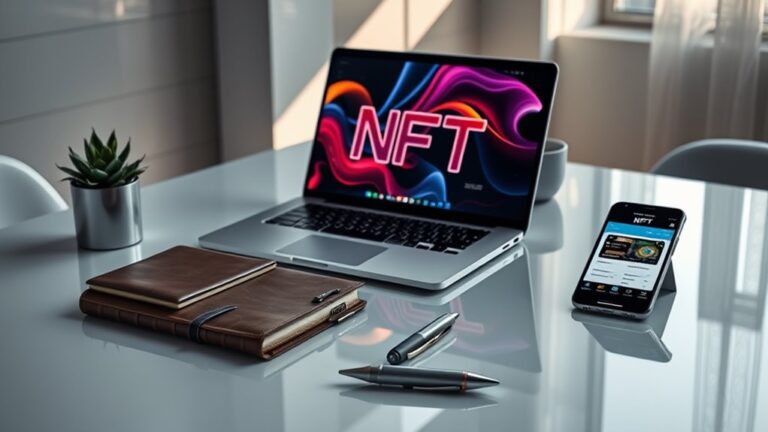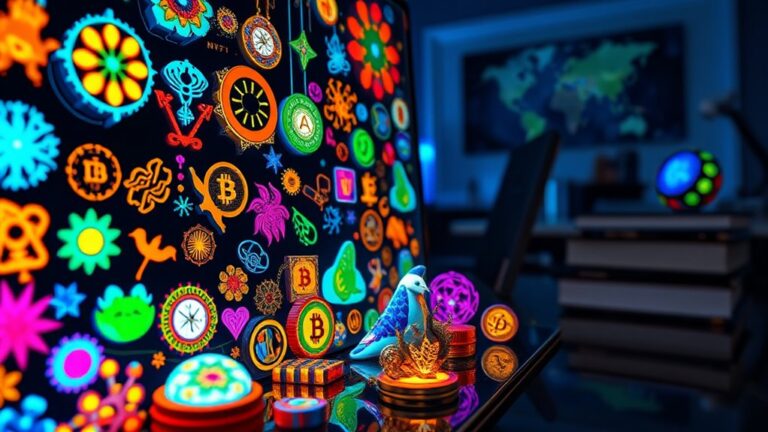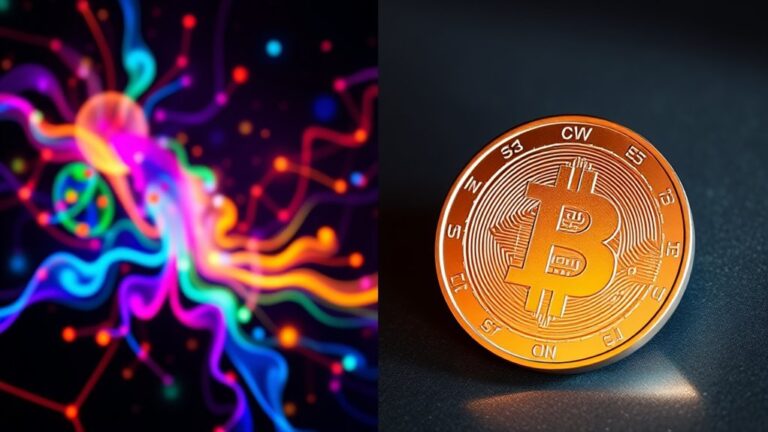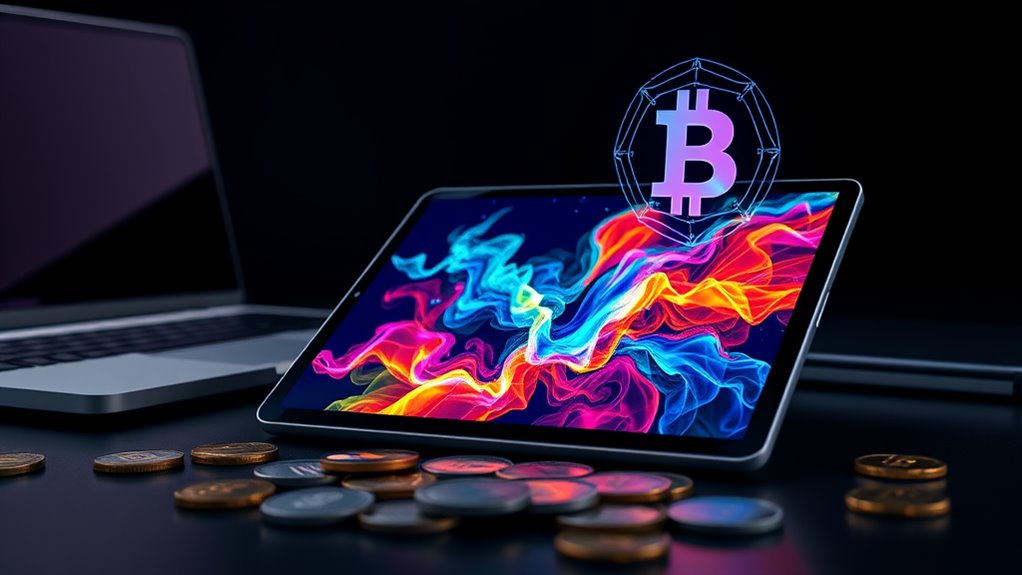
What Are NFTS and How Do They Work?
Non-fungible tokens (NFTs) are unique digital assets that represent ownership of specific items, secured on a blockchain for authenticity. They can embody various forms of content, such as art, music, and virtual real estate. The minting process involves creating a digital asset and uploading it to a blockchain, where metadata defines its attributes. NFTs provide distinct ownership but do not convey copyright. For insights on popular applications and future trends, further exploration is encouraged.
Key Takeaways
- NFTs, or non-fungible tokens, are unique digital assets stored on a blockchain, representing items like art, music, and virtual real estate.
- The minting process involves creating a digital asset, selecting a blockchain, and uploading the file with metadata to define its attributes.
- Smart contracts facilitate secure ownership assignments and enable transparent, irreversible transactions without intermediaries.
- Ownership of an NFT does not confer copyright or intellectual property rights, raising potential legal concerns.
- NFTs can be fractionalized, allowing multiple investors to co-own high-value assets, while also facing challenges like cybersecurity threats and environmental impact.
Definition of NFTs

Non-fungible tokens, or NFTs, represent a significant innovation in the digital asset landscape. Unlike cryptocurrencies such as Bitcoin, which are fungible and can be exchanged for one another, NFTs are unique and irreplaceable.
They can represent various digital files, including images, videos, and audio. NFTs are stored on a blockchain, a decentralized ledger that records ownership and authenticity, ensuring that these assets cannot be duplicated.
Common types of NFTs include digital art, music, virtual real estate, event tickets, and even domain names. NFTs are created through a process called minting, where digital assets are converted into tokens on a blockchain.
It is important to note that owning an NFT does not automatically grant copyright or intellectual property rights, which can lead to confusion regarding ownership and usage rights.
How NFTs Work
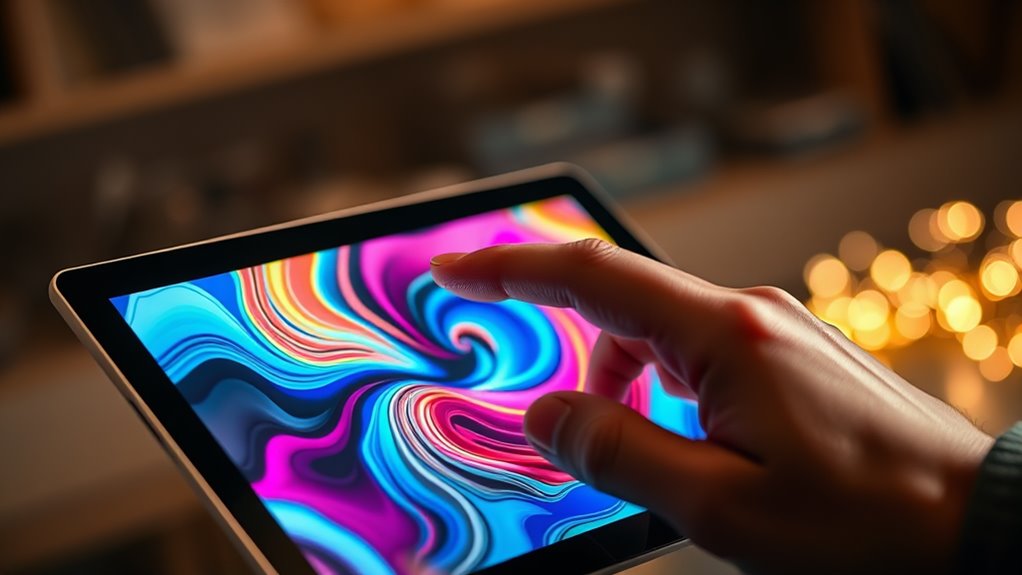
To understand how NFTs work, it is essential to explore the role of smart contracts and the minting process.
Smart contracts, primarily utilized on blockchains like Ethereum, facilitate the creation of unique tokens, ensuring that ownership is securely assigned to buyers. Additionally, during minting, metadata is established, which defines the characteristics of each NFT, making them distinct and unalterable once created. The process of NFT minting begins with creating a digital asset, ensuring creators have the rights to the content.
Smart Contracts Explained
Smart contracts serve as the backbone of non-fungible tokens (NFTs), providing a framework for their creation and management on blockchain platforms.
These self-executing contracts contain terms written in code, ensuring that agreements are automatically enforced without the need for intermediaries. Smart contracts manage the transfer of digital assets, making transactions secure, transparent, and irreversible.
They operate on popular blockchain platforms like Ethereum and execute based on preset conditions, following a deterministic logic. Once deployed, smart contracts are immutable, fostering trust among users. Additionally, they can facilitate NFT royalties that ensure creators receive compensation for their work every time their digital asset is resold.
Their applications extend to various sectors, including gaming, real estate, and finance, where they enhance efficiency, security, and transparency, ultimately streamlining processes and verifying ownership of NFTs.
Minting and Metadata
The minting process is a fundamental step in creating non-fungible tokens (NFTs), allowing digital assets to be transformed into unique items on a blockchain. This process involves several key actions:
- Digital Asset Creation: A unique digital file, such as artwork or music, is created.
- Blockchain Selection: A suitable blockchain, like Ethereum or Binance Smart Chain, is chosen for NFT creation.
- Marketplace Choice: An appropriate NFT marketplace, such as OpenSea or Rarible, is selected.
- Uploading and Setting Details: The digital file is uploaded, and metadata, including name and description, is added.
- Transaction Costs: Gas fees are paid to finalize the NFT creation on the blockchain.
This structured approach guarantees the successful minting and management of NFTs, facilitating ownership and authenticity verification. Understanding market trends can also play a crucial role in determining the potential value of the minted NFT.
The Minting Process

The minting process of NFTs involves several key steps that transform a digital file into a unique asset on the blockchain.
This process begins with the creation of the digital asset, followed by selecting a blockchain and uploading the file along with important metadata, such as a title and description.
Metadata plays a vital role in defining the NFT’s attributes and ensuring that it is easily identifiable within the marketplace. Furthermore, NFTs are increasingly utilized in gaming assets to provide players with the ability to trade and monetize their digital possessions.
NFT Creation Steps
Creating a non-fungible token (NFT) involves several essential steps that guide the process from concept to ownership on a blockchain.
The minting process requires careful planning and execution to guarantee a successful outcome. Key steps include:
- Prepare Digital Asset: Select or create a digital asset, such as artwork or music.
- Set Up a Digital Wallet: Create a digital wallet, like MetaMask, and fund it with cryptocurrency for gas fees.
- Choose an NFT Marketplace: Select a suitable platform, such as OpenSea or Rarible, for minting.
- Connect Wallet to Marketplace: Link the wallet to the chosen marketplace to initiate minting.
- Upload and Configure NFT Details: Upload the digital asset and add necessary details, such as name and description.
Additionally, it’s important to consider wallet security practices to protect your NFT investments after minting.
Metadata Importance
Metadata plays an essential role in the minting process of non-fungible tokens (NFTs), serving as the backbone for the information that defines each digital asset.
During minting, metadata, which encompasses the NFT’s name, description, and links to the digital asset, is assigned and stored on the blockchain. This process creates an immutable record that confirms ownership and authenticity, vital for preventing fraud.
Additionally, metadata facilitates the tracking of an NFT’s provenance, documenting its ownership history. The combination of a baseURI and tokenID allows access to the metadata stored off-chain, ensuring that the digital asset is consistently linked to its NFT.
This structure empowers creators by enabling control over their works and establishing digital scarcity. As the NFT market evolves, utility-driven NFTs are gaining traction, offering exclusive rewards and governance rights, making them attractive beyond mere collectibility.
Unique Characteristics of NFTs
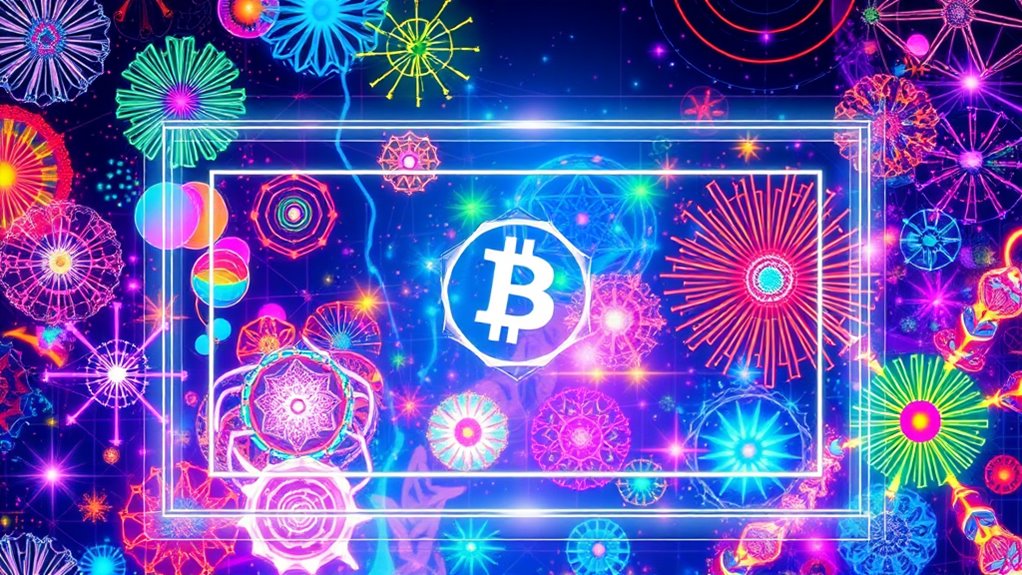
Unique characteristics set NFTs apart from traditional digital assets, making them a distinct form of ownership in the digital world. These traits contribute to their uniqueness and value, defining their role in the marketplace.
- NFTs are unique assets, not interchangeable with identical items.
- Each NFT contains distinct metadata, ensuring differentiation.
- They are stored and traded on blockchain networks for transparency.
- Ownership is verified through blockchain technology, ensuring authenticity.
- NFTs are typically indivisible but can be fractionalized for multiple ownership.
These characteristics create a robust framework for digital ownership, allowing for secure transactions and verifiable authenticity. Additionally, NFTs serve as certificates of ownership for various digital or physical assets, unlike fungible cryptocurrencies, which are primarily used for transactions and investments.
As a result, NFTs have gained prominence as a new method of managing and trading assets in various forms, from art to collectibles.
Popular Uses of NFTs
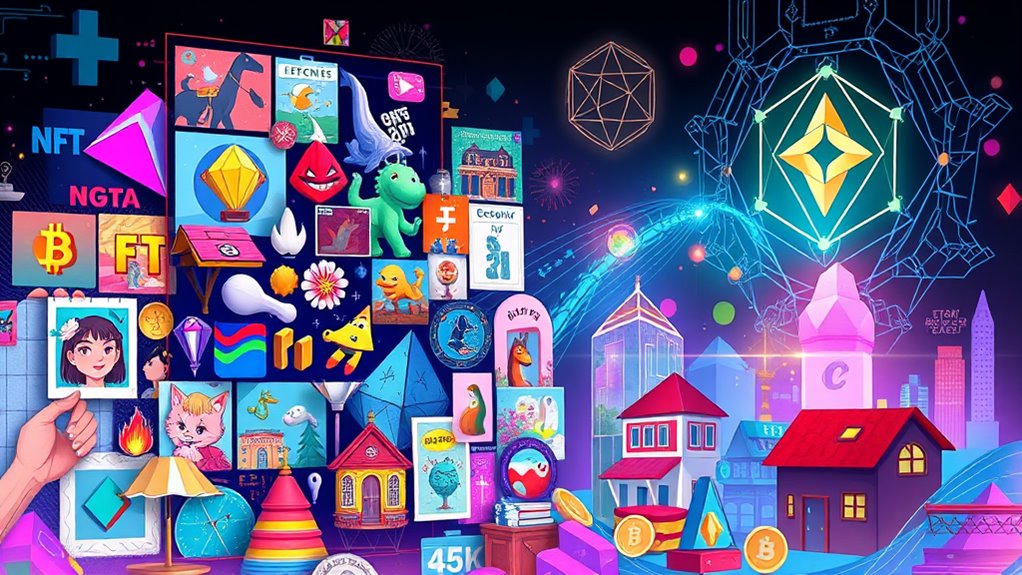
NFTs have gained widespread attention for their diverse applications across various industries.
In the domain of digital art and collectibles, artists can sell unique pieces verified on the blockchain, guaranteeing authenticity.
The gaming industry utilizes NFTs to create and trade in-game assets, such as characters and virtual lands, enhancing player experiences.
Musicians are exploring NFTs to offer exclusive music content, generating new revenue streams. This innovation empowers artists financially by allowing them to sell their work directly to fans, bypassing intermediaries and retaining control over their creations, ultimately fostering deeper connections between artists and fans.
Additionally, NFTs represent ownership of virtual real estate and sports memorabilia, such as trading cards.
In entertainment, NFTs provide unique digital experiences related to cinema and fashion, while in event ticketing, they guarantee secure, verifiable access, reducing fraud.
Benefits of NFTs

The rise of NFTs has not only transformed how digital assets are created and traded but has also introduced numerous benefits that impact owners, investors, and creators alike.
The emergence of NFTs has revolutionized digital asset creation and trading, offering significant benefits for owners, investors, and creators.
These advantages include:
- Unique Ownership: Each NFT represents a distinct digital asset, ensuring that ownership is exclusive.
- Blockchain Security: NFTs are secured on the blockchain, providing a tamper-proof record of ownership and authenticity.
- Ease of Transfer: NFTs can be transferred seamlessly across various digital platforms.
- Global Accessibility: Anyone can access NFT markets, promoting a wider range of investment opportunities.
- Fractional Ownership: NFTs allow for shared ownership, making high-value assets more accessible to multiple investors.
In addition, NFTs with practical applications, such as access to special events, may retain long-term value, making them even more desirable for collectors and investors.
Together, these benefits create a more efficient and inclusive digital marketplace, enhancing the overall experience for participants.
Challenges and Risks Associated With NFTS
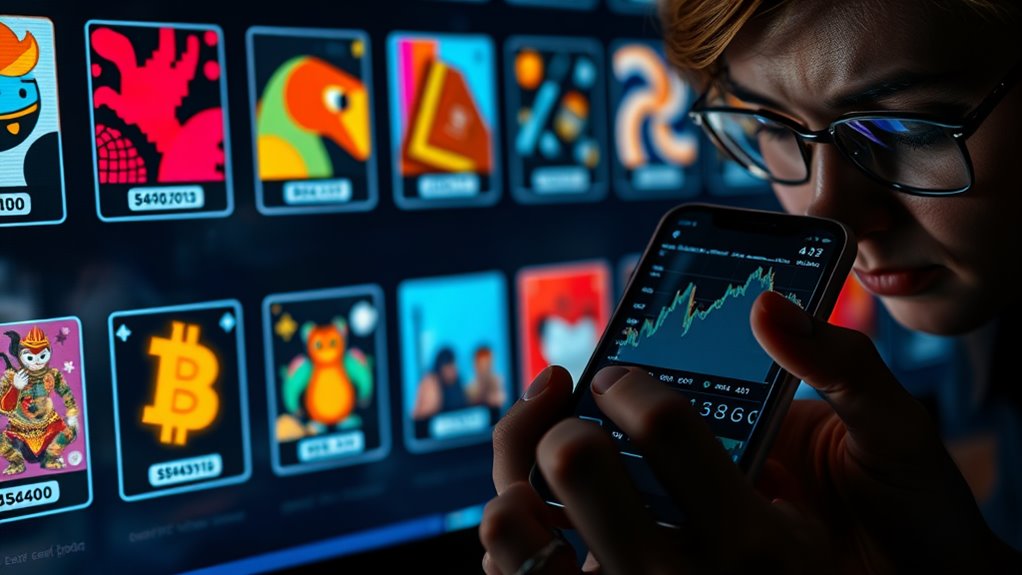
Maneuvering the complex landscape of NFTs reveals a range of challenges and risks that participants must consider.
Cybersecurity threats, such as phishing scams and malware attacks, frequently target NFT buyers, potentially leading to significant losses. Legal and regulatory uncertainties complicate the market, as NFTs lack a uniform definition, making compliance challenging across different countries.
Additionally, ownership does not guarantee full intellectual property rights, increasing the risk of copyright infringement. Economic volatility is another concern, as rapid price fluctuations can result in financial losses for investors.
Finally, environmental challenges arise from the energy-intensive nature of NFT transactions, raising questions about their sustainability. Awareness of these risks is vital for anyone engaging with NFTs.
Future Trends in the NFT Market
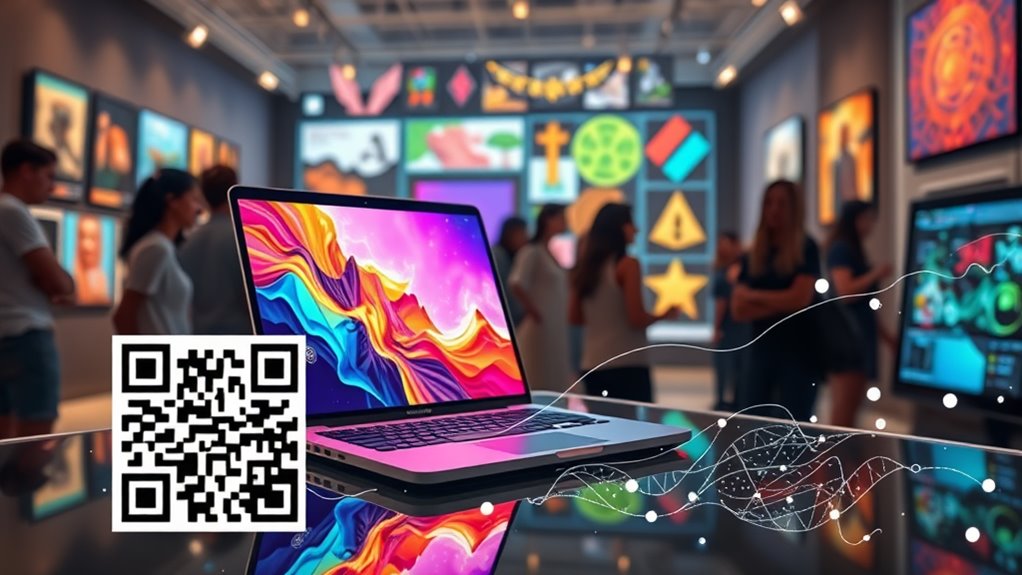
What upcoming developments might shape the future of the NFT market? As the landscape continues to evolve, several trends are emerging that could greatly impact the market.
- Rise in Utility NFTs: Offering benefits like community access and exclusive content.
- Increased Adoption of Hybrid NFTs: Combining digital and physical assets, appealing to various industries.
- Growth of Bitcoin-Based NFTs: Enhanced security and transparency through the Ordinals protocol.
- Expansion into the Music Industry: Artists leveraging NFTs for exclusive releases and ongoing royalties.
- Integration with Augmented Reality (AR): Enhancing user experiences in digital environments.
These developments indicate a broader acceptance and innovative use of NFTs, suggesting a dynamic future for this digital asset market.
Environmental Considerations of NFTs

As the NFT market continues to evolve with new trends and applications, it is essential to reflect on the environmental implications associated with this digital asset.
NFTs, particularly those minted on the Ethereum blockchain, contribute considerably to carbon emissions due to the energy-intensive processes involved in their creation and transactions. Each Ethereum transaction consumes approximately 35 kWh of electricity, comparable to a small household’s monthly usage.
While Ethereum’s shift to a proof-of-stake system has reduced energy consumption, concerns remain regarding the overall carbon footprint of NFTs.
Efforts to mitigate environmental impacts include carbon offsets and the development of sustainable blockchain technologies. As consumer awareness grows, buyers may increasingly prioritize eco-friendly platforms for their NFT transactions.
Frequently Asked Questions
Can NFTS Be Used for Physical Assets?
NFTs can indeed be used for physical assets, providing authentication and ownership verification. By linking unique identifiers to real-world items, they reduce fraud risk and facilitate efficient transactions, especially in high-value markets like art and real estate.
How Do I Buy an NFT?
In a bustling digital marketplace, seekers of rare treasures must first equip themselves with a crypto wallet, gather their coins, and navigate platforms like OpenSea or Rarible, confirming each step towards ownership of unique assets.
What Wallets Are Compatible With NFTS?
Various wallets are compatible with NFTs, including MetaMask, Coinbase Wallet, Trust Wallet, and Math Wallet. These options offer features like user-friendliness, mobile access, and cross-chain compatibility, catering to diverse needs of collectors and creators.
Can NFTS Be Resold After Purchase?
NFTs can indeed be resold, often fetching astronomical prices in vibrant marketplaces. Collectors navigate this dynamic landscape, capitalizing on trends while remaining vigilant to guarantee profitable transactions and avoid potential losses in the volatile market.
Are There Any Taxes on NFT Transactions?
Taxes on NFT transactions are generally applicable, treating them as property. Buyers and sellers must report gains and losses, while creators must declare sales as ordinary income, facing potential self-employment taxes and deducting related expenses.
Conclusion
In conclusion, NFTs represent a significant evolution in digital ownership and creativity, blending technology with art and commerce. Their unique characteristics, such as verifiable scarcity and ownership, have opened new avenues for creators and collectors alike. However, challenges such as market volatility and environmental impact remain prevalent. As the NFT market continues to evolve, it coincides with broader discussions about digital assets, prompting both excitement and caution among stakeholders in this rapidly changing landscape.



